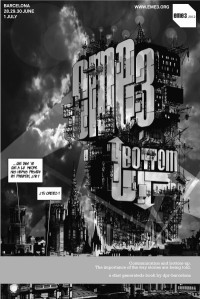When Barry Bergdoll, MoMA’s outgoing Philip Johnson Chief Curator of Architecture and Design, took the podium at an October workshop for Uneven Growth: Tactical Urbanisms for Expanding Megacities, he warmly welcomed the participants, who had gathered at the Museum from around the globe. On hand to embark on a yearlong study exploring potential architectures of global urbanism were architects and researchers from Boston and Brazil, New York and Nigeria, as well as from Spain, Switzerland, the Netherlands, India, France, Turkey, and Hong Kong, all of whom had been selected by architecture curator Pedro Gadanho. Read More …
Across our diverse fields we are tackling the question of how to better engage the bottom-up-open-source-distributed-tactical-informal-crowd phenomena surrounding us, whether in the service sector, the city, or the networked community. Read More …
The U.S. pavilion at the 2012 Venice Architecture Biennale featured American designers and artists deploying improvisational and even guerrilla tactics to make cities more sustainable, accessible, and inclusive. Hear from three of those artists whose works used heritage to create new opportunities and amenities for the public. From symbolic to practical, physical to virtual, whimsical to serious, these projects explore the interplay between unsanctioned and official, and suggest fresh tactics for engaging the public and revitalizing communities.
Mimi Zeiger, architecture journalist and critic
Richard Saxton and Stuart Hyatt, Campito, The M12 Collective
Graham Coreil-Allen, New Public Sites
Shaun Slifer, The Howling Mob Society
Advisory Board Member and Respondent
In 2030, the world’s population will be a staggering eight billion people. Of these, two-thirds will live in cities. Most will be poor. With limited resources, this uneven growth will be one of the greatest challenges faced by societies across the globe. Over the next years, city authorities, urban planners and designers, economists, and many others will have to join forces to avoid major social and economical catastrophes, working together to ensure these expanding megacities will remain habitable.
To engage this international debate, Uneven Growth brings together six interdisciplinary teams of researchers and practitioners to examine new architectural possibilities for six global metropolises: Hong Kong, Istanbul, Lagos, Mumbai, New York, and Rio de Janeiro. Following on the same model of the MoMA exhibitions Rising Currents and Foreclosed, each team will develop proposals for a specific city in a series of workshops that occur over the course of a 14-month initiative.
Uneven Growth seeks to challenge current assumptions about the relationships between formal and informal, bottom-up and top-down urban development, and to address potential changes in the roles architects and urban designers might assume vis-à-vis the increasing inequality of current urban development. The resulting proposals, which will be presented at MoMA in November 2014, will consider how emergent forms of tactical urbanism can respond to alterations in the nature of public space, housing, mobility, spatial justice, environmental conditions, and other major issues in near-future urban contexts.
Urban Case Study Teams:
New York: Situ Studio, New York, and Cohabitation Strategies (CohStra), Rotterdam
Rio de Janeiro: RUA Arquitetos, Rio de Janeiro, and MAS Urban Design ETH, Zurich
Mumbai: URBZ, Mumbai, and Pop Lab, Massachusetts Institute of Technology (MIT), Cambridge
Lagos: NLÉ Architects, Lagos, and Inteligencias Colectivas, Madrid
Hong Kong: MAP Office, Hong Kong, and Network Architecture Lab, Columbia University, New York
Istanbul: Superpool, Istanbul, and Atelier d’Architecture Autogérée, Paris

Following the debate “Communication and Bottom-UP. The importance of the way stories are being told.” we [at dpr-barcelona] are committed to expand the debates and conversations avoiding them to get lost after a few days of the event. That’s why we’re publishing this digital-pamphlet [kindle + ePub] exploring the thought and ideas of thinkers and doers; articulated by simple detonating questions posed through emails, tweets and conversations intending to communicate effectively the very essence of the debate: “the importance of telling stories.” Read More …
It’s time to put a moratorium on urban agriculture. On guerrilla street furniture. On food trucks and on yarn bombing. As a DIY enthusiast and a known proponent of tactical urbanism, I say this with a heavy heart. Read More …
This spring I presented The Interventionist’s Toolkit at a symposium hosted by the University of Sydney’s Faculty of Architecture, Design and Planning. The Right to the City, which featured an exhibition along with the symposium, brought together architects, artists, historians, theorists and journalists; organized by architect Lee Stickells and artist Zanny Begg, the program took geographer David Harvey’s 2008 essay “The Right to the City” — with its evocation of Henri Lefebvre’s influential 1968 book — as its critical springboard. As Harvey wrote: “The freedom to make and remake our cities and ourselves is, I want to argue, one of the most precious yet most neglected of our human rights.” [1]
In recent years this argument has become a rallying cry for activists who oppose the neoliberal politics and policies of the contemporary city. There’s a romantic appeal, maybe even a sense of imminent empowerment, in the prospect of remaking our cities and thus ourselves — a notion that if we change our environments we will change our lives, or vice versa. But ever since the symposium, I’ve been wondering about how we might evaluate the results of those freedoms. How to rate the diverse architectural actions and urban interventions that seek to remake the city? Do knitted cozies for stop signs or street furniture made from discarded pallets rank higher or lower than municipal cultural events? How do we measure the impacts of ambiguously defined and informal activities that are not only creative and civic but also — lest we forget Harvey’s ourselves — emotionally charged?